![[Royal Norfolk and Suffolk Yacht Club burgee]](../images/g/gb~nsb.gif) image by Clay Moss, 19 August 2014
image by Clay Moss, 19 August 2014
Last modified: 2017-12-30 by rob raeside
Keywords: royal norfolk and suffolk yacht club | red ensign | feathers |
Links: FOTW homepage |
search |
disclaimer and copyright |
write us |
mirrors
![[Royal Norfolk and Suffolk Yacht Club ensign]](../images/g/gb~ns.gif) image by Clay Moss, 19 August 2014
image by Clay Moss, 19 August 2014See also:
Other Sites:
The Royal Norfolk and Suffolk Yacht Club was founded in
1859. I'm not sure when the ensign was officiated. You can visit the club's
website at
http://www.rnsyc.net/wordpress/about-the-club/history/.
Clay Moss, 1 February 2006
That same
web page (quoting "The First 125 years", by Charles Goodey, included in
RNSYC, 125 Years Sailing, 1859-1984, a commemorative booklet published in 1984
to mark the 125th Anniversary of the club's foundation) states "Mrs. Colman
broke the club flag over the new headquarters for the first time." on 11 July
1903, so a club flag was certainly in existence on that date.
Colin Dobson, 1 February 2006
A Red Ensign defaced with the Prince of Wales feathers is
shown in the Admiralty Flag Book of 1875 as being that of the Norfolk and
Suffolk Yacht Club. It is marked "No Warrant : Ensign Illegal".
The Norfolk and Suffolk Yacht Club was granted a Red Ensign defaced with a crown
and Prince of Wales feathers in February 1898. On 17 March 1898 the club applied
to the Home Office for the right to add "Royal" to the club's name, adding that
the club had been established for fifty years, had an Admiralty Warrant, and
that its members had twelve yachts with a total tonnage of 470. The Home Office
checked with the Admiralty who confirmed the warrant, but stated that they did
not offer opinions on use of the title Royal. The application was laid before
Queen Victoria on 3 May 1898, but refused on the grounds that the club was not
sufficiently important. In 1909 the Home Office found that ten yacht clubs
that called themselves Royal, were doing so without authorisation; one was the
Norfolk and Suffolk. When the matter was investigated it was found that the
Admiralty had incorrectly made out the warrant to the Royal Norfolk and Suffolk
Yacht Club. The Home Secretary then appears to have been approached personally,
as the club claimed that Matthew Ridley had said "you have what you wanted." The
club had therefore been using the title since June 1898. The Admiralty claimed
that the Home Office had not told them that the title had been refused. The
title was officially granted to the club on 18 May 1909.
[National Archives (PRO) HO 144/605/B26398]
David Prothero, 1 February 2006
The feathers are gathered in a Prince of Wales coronet.
When the Norfolk & Suffolk Yacht Club applied for a special ensign the warrant
was mistakenly made out to the Royal N & SYC, and as a consequence a royal crown
was incorrectly included in the defacement. Don’t expect yacht club special
ensigns to be consistent. The Royal Welsh Yacht Club ensign has the Prince of
Wales feathers and a royal crown, but the Royal Cornwall Yacht Club ensign has
the Prince of Wales feathers and no royal crown.
David Prothero, 16
April 2015
![[Royal Norfolk and Suffolk Yacht Club burgee]](../images/g/gb~nsb.gif) image by Clay Moss, 19 August 2014
image by Clay Moss, 19 August 2014
The Dumpy Book of Ships and the Sea (1957)
shows the burgee as the Prince of Wales ostrich feathers surmounted by a crown
on a red field.
James Dignan, 12 February 2008
Burgee used 1898(?) to present.
Peter Edwards, 22 November 2017
![[Royal Norfolk and Suffolk Yacht Club]](../images/g/gb~nsbad.gif) image based on art by Clay Moss, 19 August 2014
image based on art by Clay Moss, 19 August 2014
Admiral’s Distinguishing Flag 1996 - Present.
Rectangle 3:5. Red field superimposed slightly off-centre by Prince of Wales feathers with crown.
Image: Club’s 2017 Yearbook.
Peter Edwards, 22 November 2017
![[Royal Norfolk and Suffolk Yacht Club]](../images/g/gb~nsbco.gif) image based on art by Clay Moss, 19 August 2014
image based on art by Clay Moss, 19 August 2014
Commodore’s Distinguishing Flag 1899 to Present.
Swallowtail 3:5. Red field superimposed in centre (hoist to crutch) by Price of Wales feathers with crown.
Vice Commodore: same as Commodore but with one white circle in canton.
Rear Commodore: same as Commodore but with two white circles spaced horizontally in canton.
Image: Club’s 2017 Yearbook.
Peter Edwards, 22 November 2017
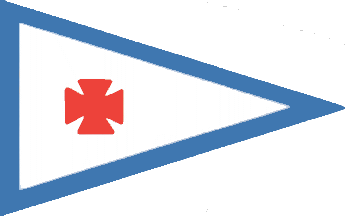 image
located by Peter Edwards, 22 November 2017
image
located by Peter Edwards, 22 November 2017
Pennant: 2:3. White field fimbriated blue and superimposed by red Maltese Cross centred 2 units from hoist.
"[In 1867] . . . the Prince of Wales agreed to become the club patron and the club changed its burgee to a blue Prince of Wales feathers on a white background [see below]. Within two years members decided that white plumes on a red background [see below] looked better and changed the burgee again."
Image and Quote: Campbell, Jamie. The Royal Norfolk & Suffolk Yacht Club (2009).
Peter Edwards, 22 November 2017
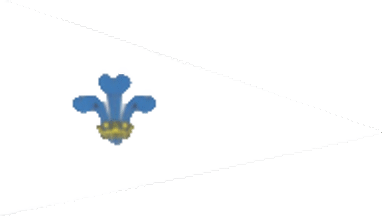 image
located by Peter Edwards, 22 November 2017
image
located by Peter Edwards, 22 November 2017
Image: Campbell, Jamie. The Royal Norfolk Suffolk Yacht Club (2009).
Peter Edwards, 22 November 2017
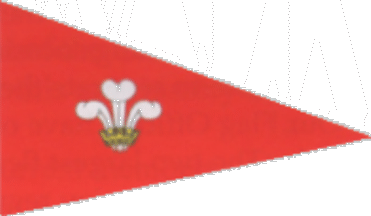 image
located by Peter Edwards, 22 November 2017
image
located by Peter Edwards, 22 November 2017
Image: Campbell, Jamie. The Royal Norfolk & Suffolk Yacht Club (2009).
Peter Edwards, 22 November 2017
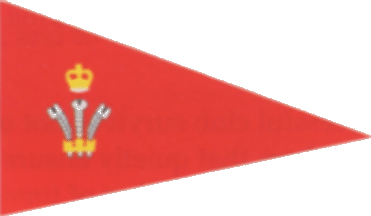 image
located by Peter Edwards, 22 November 2017
image
located by Peter Edwards, 22 November 2017
Image: Campbell, Jamie. The Royal Norfolk & Suffolk Yacht Club (2009)
Peter Edwards, 22 November 2017
 image
located by Peter Edwards, 22 November 2017
image
located by Peter Edwards, 22 November 2017
Broad Pennant 1:2. White field fimbriated blue superimposed with three red Maltese Crosses.
Vice Commodore: Same as Commodore but with two crosses.
Rear Commodore: Same as Commodore but with one cross.
Image: Club’s 2017 Yearbook.
Peter Edwards, 22 November 2017
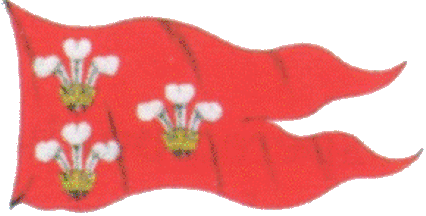 image
located by Peter Edwards, 22 November 2017
image
located by Peter Edwards, 22 November 2017
Broad pennant. 1:2. Red field superimposed by three Prince of Wales feathers.
Vice-Commodore’s distinguishing flag: same as Commodore but with two Prince of Wales feathers.
Rear- Commodore’s distinguishing flag: same as Commodore but with one Prince off Wales feathers.
Image - Campbell, Jamie. The Royal Norfolk & Suffolk Yacht Club (2009).
Peter Edwards, 22 November 2017
"The first club burgee was a white flag bearing a red cross of St. George."
Club website:
http://www.rnsyc.net/wordpress/about-the-club/history
Peter Edwards, 19 November 2017